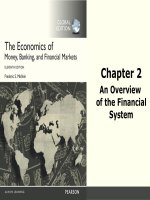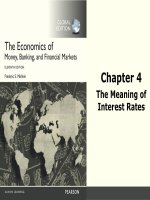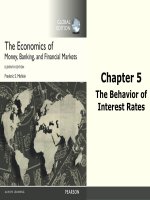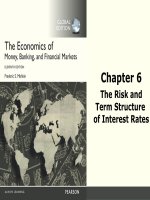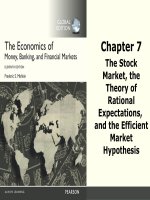The economics of money, banking, and financial institutions 2nd ch18
Bạn đang xem bản rút gọn của tài liệu. Xem và tải ngay bản đầy đủ của tài liệu tại đây (4.35 MB, 35 trang )
Chapter 18
Conduct of Monetary
Policy: Goals and
Targets
© 2005 Pearson Education Canada Inc.
Goals of Monetary Policy
Goals
1. High Employment
2. Economic Growth
3. Price Stability
4. Interest Rate Stability
5. Financial Market Stability
6. Foreign Exchange Market Stability
Goals often in conflict
© 2005 Pearson Education
Canada Inc.
18-2
High Employment
High employment is a worthy goal for two reasons:
1. The alternative situation, high unemployment, causes much human misery, with
people suffering financial distress, loss of personal selfrespect, and in crime.
2. When u is high, the economy has not only idle workers but also idle resources,
resulting in a lower GDP.
But how low should u be? Because frictional unemployment (which involves
searches by workers and firms to find suitable matchups) is desirable, and
because policy can do little about structural unemployment (due to a mismatch
between job requirements and the skills of workers), the goal of high
employment should seek not u = 0 but u > 0 consistent with full employment (at
which the demand for labor equals the supply of labor). This level of u is called
the natural rate of unemployment.
© 2005 Pearson Education
Canada Inc.
18-3
Economic Growth
The goal of steady economic growth is closely related to the
goal of low u because businesses are more likely to invest in
physical capital to productivity and growth when u is low.
If u is high and factories are idle, it does not pay for firms to
invest in additional physical capital.
Hence, policies can be specifically aimed at promoting
economic growth by directly encouraging firms to invest or by
encouraging people to save, which provides more funds for
firms to invest. In fact, this is the stated purpose of so-called
supply-side economic policies, which provide tax incentives for
firms to invest more and for people to save more.
© 2005 Pearson Education
Canada Inc.
18-4
Price Stability
In recent years policymakers have become increasingly
aware of the social and economic costs of inflation and more
concerned with a stable P as a goal of economic policy.
In fact, P stability is viewed as the most important goal for
monetary policy because
1. inflation creates uncertainty that may hamper growth
2. inflation makes it hard to plan for the future
3. inflation may strain a country’s social fabric (by creating
conflicts between different groups)
4. extreme inflation, known as hyperinflation, leads to slower
growth as for example in Argentina, Brazil, and Russia in
the recent past.
© 2005 Pearson Education
Canada Inc.
18-5
Interest-Rate Stability
• Interestrate stability is desirable because fluctuations in
interest rates can create uncertainty and make it harder (for
both firms and households) to plan for the future.
• A central bank may also want to reduce upward
movements in interest rates because such movements
generate hostility toward central banks and lead to
demands that their independence and power should be
reduced (see Chapter 14).
© 2005 Pearson Education
Canada Inc.
18-6
Stability of Financial Markets
• Financial crises can interfere with the ability of financial
markets to channel funds from surplus spending units to
deficit spending units, thereby leading to a sharp contraction
in economic activity.
• The promotion of a more stable financial system in which
financial crises are avoided is thus an important goal for a
central bank.
• The stability of financial markets is also fostered by i
stability because fluctuations in i create uncertainty for
financial firms, affecting both their profits as well as their
net worth.
© 2005 Pearson Education
Canada Inc.
18-7
Stability in Foreign Exchange
Markets
E
euro
$
• The value of the $ has become a major consideration for the
Bank of Canada. An in E makes Canadian industries less
competitive with those abroad and a in E stimulates
inflation in Canada.
• Also preventing large changes in E makes it easier for firms
and people involved in international trade to plan ahead.
• Stabilizing extreme movements in E in FX markets is thus
viewed as a worthy goal of monetary policy. In fact, in
countries which are even more dependent on foreign trade,
stability in FX markets takes on even greater importance.
© 2005 Pearson Education
Canada Inc.
18-8
Conflict Among Goals
• Many of the goals mentioned are consistent with each other
as, for example,
• high employment with economic growth, and
• i stability with financial market stability.
• However, P stability is in conflict with i stability and low u
in the short run (but probably not in the long run). For
example, when the economy is expanding and u both
and i may start to . If the Bank tries to prevent an in i, this
may cause the economy to overheat and stimulate . But if
the Bank i to prevent , in the short run u may .
• The conflict among goals may thus present central banks
with some hard choices!
© 2005 Pearson Education
Canada Inc.
18-9
Central Bank Strategy
© 2005 Pearson Education
Canada Inc.
18-10
Use of (Operating and Intermediate)
Targets
• Suppose that the Bank wants to achieve a 5% rate of growth for
nominal GDP and is targeting an aggregate (say M1+). If the
Bank feels that the 5% nominal GDP growth rate will be
achieved by a 4% growth rate for M1+ (its intermediate target),
which will in turn be achieved by a 3% MB growth rate (its
operating target), it will use its tools to achieve the 3% MB
growth rate.
• After implementing this policy, if the Bank finds that MB is
growing too slowly, it can use open market purchases to
increase it. Somewhat later the Bank will begin to see how its
policy affects the growth rate of M1+. If M1+ is growing too
fast (say at 7%), the Bank will reduce its open market purchases
or make open market sales to reduce the M1+ growth rate.
© 2005 Pearson Education
Canada Inc.
18-11
Money Supply Target
1. M d fluctuates between
M d' and M d''
2. With Mtarget at M*, i
fluctuates between i'
and i''
© 2005 Pearson Education
Canada Inc.
18-12
Interest Rate Target
1. M d fluctuates
between M d' and
M d''
2. To set itarget at i*
Ms fluctuates
between M' and M''
© 2005 Pearson Education
Canada Inc.
18-13
Choosing Targets
The conclusion from Figures 182 and 183 is that interest rate and
monetary aggregate targets are incompatible: a central bank can
hit one or the other but not both.
Because a choice between them has to be made, we need to
examine what criteria should be used to decide on the target
variable.
© 2005 Pearson Education
Canada Inc.
18-14
Criteria for Choosing Targets
Criteria for Intermediate Targets
1. Measurability
2. Controllability
3. Ability to Predictably Affect Goals
Interest rates aren’t clearly better than M s on criteria 1 and 2
because hard to measure and control real interest rates
Criteria for Operating Targets
Same criteria as above
Reserve aggregates and interest rates about equal on criteria 1 and 2.
For 3, if intermediate target is M s, then reserve aggregate is better
© 2005 Pearson Education
Canada Inc.
18-15
History of Bank of Canada Policy
Procedures
Early Years: Interest Rate Targeting
19621971, Fixed exchange rate (Bretton Woods System)
19711975, Flexible exchange rate
Result: During the early years, i or (i i*) were the intermediate
target of Canadian monetary policy and the Bank’s objective
was to keep the FX market and domestic bond markets
functioning smoothly. The Bank paid no attention to the
growth rate of M. As a result, monetary policy was
expansionary and by 1974 to double digits (to 11%)
©compared to only 3% in 1971.
2005 Pearson Education
Canada Inc.
18-16
Inflation Rates
During the early years, i or (i - i*) were the
intermediate target of Canadian monetary
policy. As a result, i and followed
generally similar patterns in Canada and the
U.S.
Interest Rates
© 2005 Pearson Education
Canada Inc.
18-17
Targeting Monetary Aggregates: 1975-81
By the end of 1975 there was a consensus among central
banks that fluctuations in M contained useful information
about P and Y. This evidence contributed to the rise of
monetarism (a theory that emphasized a steady, predictable
). In response to this and the rising in the early 1970’s,
the Bank introduced a program of “monetary gradualism,”
under which M1 growth would be controlled within a
gradually falling target range (see Table 181). The Bank,
however, continued to use an interest rate as its operating
target
Result: Bank was successful at keeping actual M1 growth
within the target range (see Table 181), but because of a
series of financial innovations that the demand for M1 and
the demand for M2. Monetary targeting was abandoned in
© 2005
Pearson Education
November 1982.
Canada Inc.
18-18
The Bank was to announce in advance (in order to influence people’s
expectations) the target path for the growth of M1 and then adjust policy
during the course of the year to make the actual growth rate lie within the
target range.
© 2005 Pearson Education
Canada Inc.
18-19
The Checklist Approach: 1982-88
With the abandonment of M1 targets, the Bank focused on a list
of factors, including i, E, and broad monetary aggregates (like
M2 and M2+), but no aggregate was found suitable as a guide
for conducting monetary policy.
The goal of monetary policy was containment in the short term
and price stability in the long term
i was the operating target and E was the intermediate target
(with the Bank resisting in E, fearing that depreciation would
worsen )
Result: again (because of a persistent federal budget deficit
that made it difficult for the Bank to control M and ). The Bank
responded by announcing early in 1988 that shortterm issues
©would henceforth less guide policy and that P stability would be
2005 Pearson Education
Canada
Inc.
the Bank's longterm objective of monetary policy
18-20
Inflation Targeting: 1989-Present
•
•
•
•
•
In February 1991, the Bank and the minister of finance
“jointly” announced explicit targets for , with a band of ±1%
around them.
The targets were 3% by the end of 1992, falling to 2% by the
end of 1995, to remain within a range of 1 to 3% thereafter.
The 1% to 3% target range for was renewed in 1995, in early
1998, and again in May 2001, to apply until the end of 2006
The midpoint of the current target range, 2%, is regarded as
the most desirable outcome
In setting its targets, the Bank uses inflation in "core CPI"
which excludes volatile components (such as food, energy,
and the effect of indirect taxes)
Defining the targets in terms of ranges gives the Bank
sufficient flexibility to deal with supply shocks
© 2005 Pearson Education
Canada Inc.
18-21
Inflation Rate and Inflation Targets for
Canada, 1980-2002
© 2005 Pearson Education
Canada Inc.
18-22
International Considerations
• Globalization (the growing integration and interdependence of
national economies) has also affected Bank of Canada
policymaking in recent years.
• Globalization requires international policy cooperation, to
improve the functioning of international financial markets and
the efficiency of domestic monetary policy.
• International cooperation has been encouraged by the process of
international policy coordination (agreements among countries
to enact policies cooperatively) that led to the Plaza Agreement
in 1985 and the Louvre Accord in 1987.
© 2005 Pearson Education
Canada Inc.
18-23
The Plaza Agreement and the Louvre
Accord
• The Plaza Agreement was reached at New York’s Plaza Hotel in
September of 1985 between finance ministers and the heads of
central banks from the Group of Five (G5) the U.S., the
U.K., France, West Germany, and Japan. It was agreed to bring
down the value of the U.S. $ to address U.S. concerns that the
strong U.S. $ was reducing the competitiveness of American
corporations.
• By 1987 the U.S. $ had indeed by about 35% relative to other
currencies. At this point to address concerns over the significant
in the U.S. $, policymakers from the G5 plus Canada met in
February 1987 at the Louvre Museum in Paris and agreed to
stabilize exchange rates around the then prevailing levels.
© 2005 Pearson Education
Canada Inc.
18-24
Inflation Targeting
Five Elements
Public announcement of mediumterm target
Institutional commitment to price stability
Information inclusive strategy
Increased transparency through public communication
Increased accountability
© 2005 Pearson Education
Canada Inc.
18-25

